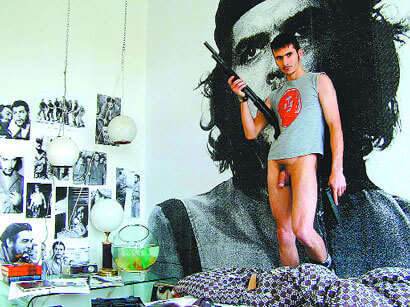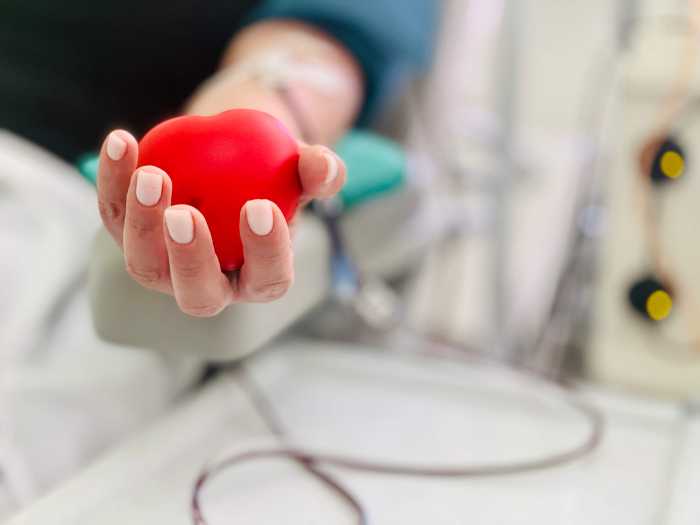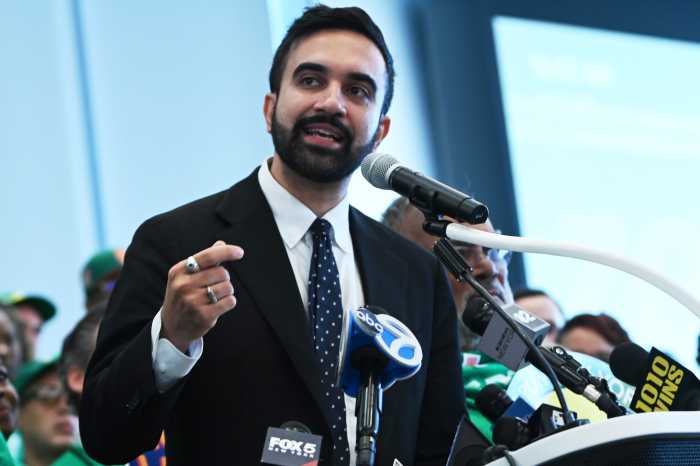Bruce LaBruce’s “The Raspberry Reich” storms “NewFest” with frank sexuality that’s not faked
“I’m totally down with the idea that private property is theft,” director Bruce LaBruce announced. “I would be ethically comfortable with any kind of crime against property.”
The irony that LaBruce was making this statement poolside at Miami’s swank National Hotel wasn’t lost on either of us, but we were there to talk about his latest film, “The Raspberry Reich.”
LaBruce’s many tattoos peeked out from under a short sleeve flannel shirt. His hair was red that week and a few days in the South Beach sun saw him a bit more sunburned than he was at the opening night party. He was enjoying some well-deserved down time after unveiling his latest film for a gay audience after it premiered at the Berlin Film Festival and stirred up Sundance.
His midnight screening played at the Miami Gay and Lesbian Film Festival on two sold-out screens, and the notorious Sundance walkouts didn’t repeat themselves.
“Sundance is much more conservative,” LaBruce explained. “They’re a hyper-industry crowd. You could tell some walkouts were based strictly on the fact there was unsimulated gay sex. A dozen people would walk out actually during the sex scenes. In Miami, anyone who left returned quickly with popcorn. It’s quite a pill for certain audiences to swallow. But I wanted it to be accessible enough so that people would take it seriously.”
The film takes its name from the group of affluent German lefties who supported the Red Army Faction (aka the Baader Meinhof Gang) as they executed dozens of high profile Germans. Susanne Sachsse plays Gudrun, radically chic in outsized shades, leading her merry band of gay terrorists in kidnapping the hunky son of a German industrialist whom they pass around in an effort to throw off bourgeois capitalist constructs and mount a homosexual revolution.
That’s right, gay terrorists.
Still, property is one thing, but even LaBruce admitted, “When you get into murder, it’s morally unsupportable. It’s a pretty gentle movie if you think about it, but it operates as a critique of the left. People with these left-wing sympathies who cross the line and become terrorists essentially cancel out any moral authority they had because they cross a line. They become murders. Then it’s all about moral ambiguity and becomes very murky.”
Murky is something he needn’t sweat. The film is all candy colors and swirling slogans like “Join the homosexual intifada” and “Madonna is counter revolutionary,” and looks more like Harper’s Bazaar than a skin flick.
Still, the film was a balm coming on the heels of an afternoon screening of a documentary detailing the world’s largest rainbow flag being unfurled across Key West by thousands of volunteers all sporting white T-shirts emblazoned with “Absolut Rainbow.”
“The rainbow flag has lost all vestige of radicalism or militancy,” LaBruce said. “Any symbol is bound to become eventually exhausted or exploited, but maybe it’s time for something new. The gay movement that produced that flag and the gay movement that exists today are worlds apart. The feminist, black, and gay movements all came out of 60s radicalism. Anti-Vietnam war demonstrations, student protests, and an emerging sexual freedom simultaneously happened in Europe and the U.S., but those movements were militant, stylish, and forward thinking in trying to imagine different social situations and sexual configurations. They were totally nonconformist and radical. Thirty years later the oppressed has become the oppressor. The black movement started out as the Black Panthers. They were Marxist-based and militant, open to feminism, they weren’t particularly homophobic, and now the black mainstream hip-hop movement is the opposite of all those things. It’s totally capitalist, sexist, and homophobic.”
“I tried to salvage the idea of a gay movement with this movie,” LaBruce added. “Gay culture has become so bourgeois, conservative, and assimilationist that one can easily abandon it altogether. But what I did was actually convert some straight characters into homosexuality, but the homosexual community I portray at the end of the movie is a fantasy. It’s a gay bar where they have a terrorist night and they’re booing a drag queen dressed as Patty Hearst singing the American national anthem. You’d be hard pressed to find a gay bar like that anywhere.”
But you might come closest in Berlin, which is where LaBruce decided to shoot “The Raspberry Reich,” upping the ante by simultaneously filming an art house and hardcore version of the film. Aside from Sherry Vine playing the Hearst drag queen, the rest of the cast were German porn actors given incredibly complicated lines of complex revolutionary rhetoric in English.
“To expect an actor to say a line like, ‘Don’t you understand the fundamental dynamics of terrorist abduction,’” Bruce said, shaking his head and laughing. “And not only a porn actor, but a German porn actor whose English isn’t very good. It was insane.”
So why do it?
At first, LaBruce claimed he wanted the film “to look like a dubbed old European movie that you would see on television.” He can be artsy like that and what’s essentially a technical limitation has worked beautifully for him in the past.
“‘Raspberry Reich’ was totally post-dubbed,” LaBruce continued. “They were saying their lines in English. I knew during rehearsals that I would have to post-dub everything so during filming it was just a question of getting them to actually say the lines, forget about the delivery, just get their lips to move.”
But LaBruce got more than just his actors lips moving. The penetrative heterosexual sex scene that opens the film and the many gay sex scenes and assorted blowjobs that follow may have also had something to do with his casting choices.
LaBruce, however, is unapologetic. His friend John Cameron Mitchell’s “Sex Project” film project illustrates the pitfalls of doing a sexually explicit film the other way, he explained.
“It sounds like he’s having trouble with the process because he’s running into the age-old dilemma by trying to get real actors to do sexually explicit roles,” LaBruce said. “But they’re getting cold feet because it’s still a huge stigma for actors. The point of my movies is that I’m using porn actors or non-actors who don’t have aspirations to be real actors. They’re willing to perform sexually. They don’t really have anything at stake.”
Sachsse, a stage actress in Berlin, is an exception, though.
“When people got wind she was in a porn movie, it was this huge scandal, even on the Berlin theater scene, which is completely outlandish,” LaBruce explained. “There were rumors she was just doing it for the money, which is a joke because there was no money. She lost her agent because of it. It’s still a stigma whenever you do it.”
Still, LaBruce maintained he’s not making calling card films as a means to work with established actors one day.
“Doesn’t really interest me,” is how he greeted the idea. “Established actors are already like porn actors because they’re emotionally promiscuous. To me, watching two established stars slobber all over one another is even more pornographic than two porn stars having mechanical sex. It gives me that same feeling as watching creepy porn.”
LaBruce’s attitude may sound callous, but it’s not as if choosing to work in a sexually explicit format hasn’t also had repercussions on his career. He referred to a recent solo show of his photography at the Chelsea gallery John Connelly Presents.
“I’m working within the porn idiom, which is very specific and has its own set of conventions,” he explained. “I obviously try to subvert it and politicize it and alter it aesthetically as much as I can without completely abandoning the porn aesthetic.”
At the Connelly show, that translated to images of men in pig masks engaged in oral sex while splattered with blood or a pregnant Asia Argento enjoying a cigarette.
“I was being deliberately provocative,” LaBruce admitted. “I have pictures of guys that look like terrorists. One of the photos is of my boyfriend, who’s a Muslim, praying. It’s called ‘Dreamy Terrorist.’ He’s the guy at the beginning and end of ‘Raspberry Reich.’ And then I juxtaposed these images with guys with hard-ons or gas masks. Then there was a photo of Kembra Phaler with her black burqua showing her pussy and a nun showing her pussy. I was deliberately playing with ideas of religious and pornographic iconography and mixing them up. I was pushing buttons in that way, but I heard just on the grapevine that the art scene in general dismissed the show as too pornographic. The opening was amazing, but the show hardly got written about.”
One might suspect that LaBruce couldn’t care less about an art world he described as “a real mafia like anything else.” But, that’s not exactly the case.
“In order to sustain a presence in that scene, you need to be acknowledged,” he explained. “There’s a gay art mafia within the art mafia.”
While his credibility with them is lacking, his introduction to that world was typical LaBruce.
“I am primarily known as a filmmaker, but I was in between movies and needed to make some money so I started shooting for gay jerk-off magazines like Honcho and Playguy,” he recalled. “The first photo show I had was in Milan. They approached me because of my Honcho stuff, but I’m certainly not a trained photographer. I started hiring assistants to help me with these Honcho type shoots and I would just observe my assistants and learn from them. By coincidence, I started hanging out with Terry Richardson and Ryan McGinley. Ryan was a student at Parsons and we all started running around with these chic point and shoot cameras.”
The art world held a lesson more valuable for LaBruce than a portfolio of “Honcho-type shots” and party pictures.
“Photography has taught me increasingly that it’s all about context,” he explained. “I can take a photograph of a naked guy with a hard-on and publish it in Honcho and it’s porn. I have taken, literally, the same photograph, put a nice frame around it and hung it in an art gallery and it’s art.”
But don’t expect any Mapplethorpe Cincinnati grandstanding from LaBruce. He is very clear about the line between art and pornography that divides his oeuvre.
“Mapplethorpe’s work was always coded very heavily as art,” LaBruce said. “There’s a black and white, high art aesthetic. You look at it and you didn’t really see pornography. My work sometimes is very blatantly pornographic. That causes certain people in the art world to dismiss it. To ignore someone is really the worst thing you can do and some people have been very good about doing that to me. The art scene is just like America—it’s swung way to the right.”
So if LaBruce’s work is concerned with pushing buttons, American sensibilities have certainly been favorite targets. The last time I saw one of his films at a festival, it was a short at New Fest in the difficult year after 9/11. LaBruce’s film was part of a mixed bill organized around the idea “raw.” To the blare of Nancy Sinatra’s “These Boots Were Made For Walking,” LaBruce’s three-minute films opens on a masturbating hustler disguising his identity with a kinky leather hood. As the song winds down, so does the hustler, ejaculating onto an American flag the camera pulls back to reveal him crouching over. As a final flourish, he reaches down and uses the flag to wipe the semen from his uncut penis. I’ve never sat through a quieter three minutes and the silence blanketed the rest of the program. Leaving the auditorium, someone broke it loudly by exclaiming, “And he’s not even American!”
Which is true—LaBruce grew up on a farm in Ontario and today calls Toronto home.
Perhaps it’s this built-in outsider status that is LaBruce’s raison d’être. In Filmmaker magazine, J.T. Leroy told LaBruce, “You can go to that place of the outsider, and capture the eroticism of it. I guess that a lot of your movies straddle that world of the political, the sexual. They tie it all in. It’s kind of some daring worlds you explore there.”
Having just polished off a major slice of German history shooting “The Raspberry Reich” in Berlin, LaBruce will next return to Los Angeles where he last chronicled the hustling trade in a film, “Hustler White,” that’s sure to be remembered as his “Citizen Kane.”
“I want to do one more porn movie rounding out a trilogy, he said. “It is called ‘L.A. Gangbangers’ and it’s about Latino gang members in Los Angeles.”
The project after that is larger in scope and is attached to Toronto-based producer Jennifer Jonas. It will finally put him back in front of the camera and also stars Asia Argento.
“It’s based on Baron Wilhelm Von Gloeden, the German photographer who lived in Sicily at the end of the 19th century and took photos of the local boys naked,” LaBruce said. “He became this world-renowned photographer for these photos that some people thought were very questionable in terns of whether they were pornographic or not. The film is an investigation of him, his work and his life. I play this character who goes there to make a film about him, but I run into resistance because the people I’m trying to talk to about Von Gloeden, their grandfathers were posing naked for him, so they don’t really want to talk about it.”
LaBruce speculated on political prospects here in the U.S.
“We’re in a really bad historical moment,” he said. “It’s about the ascendance of American imperialism and the Republicans consolidating power. I don’t think it can sustain itself. Those rifts are starting to form again and I think there’ll be a new radicalism, but I don’t know when.”
So “The Raspberry Reich” could be a cautionary tale, albeit a fashionable one.
“When I was a punk in the 80s,” LaBruce recalled, “we really were interested in all of these terrorist groups because the left-wing dogma underpinning all of them actually made a lot of sense, but we were also drawn to them because they were these very glamorous figures. There was a militant style that all the radical groups adopted borrowing from Central and South American guerilla prototypes that made them very trendy among people who had leftist leanings, but were nonetheless rich and glamorous Hollywood types.”



































